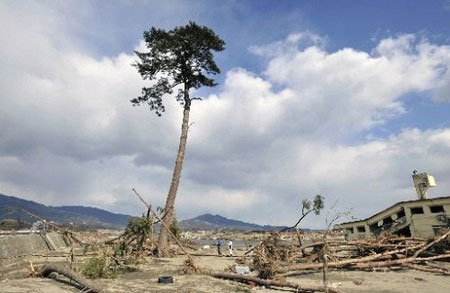The only story about pine trees left after the Japanese tsunami
The only 'survivor' in the 70,000 pine forest that once stood in front of the sea in Rikuzentakata has become a symbol of hope in Japan, when the country struggled in the March 11 disaster last year. But now, the 'pine of hope' is dying.
Few could stand in the city of Rikuzentakata after the cataclysm swept a year ago. Even with the coastal pine forests that have existed for centuries, pine forests have become a symbol of the city, also wiped out.
But amid the widespread destruction, killing one-third of the city's population, a single pine among 70,000 trees managed to survive. Pine trees become a symbol of people's hope for a fresh tomorrow.
'At that time, we had no hope. So there was one thing that survived like a glimmer of light in the darkness , "said Seiko Handa, 47,.

The "tree of hope" stands in the middle of the devastating destruction.
But now the 250-year-old pine tree is dying, because the tsunami has left sea salt water on the ground.
'From the beginning when we took care of the tree, we also worried that it would die slowly,' said Kazunari Takahashi, an official from the Forest, Fisheries and Agriculture Department.
Cultivated for the purpose of sand and sea salt protection in the city, the dense pine forest known as Takata-Matsubara stretches about 2km along the coast and has become one of the locations famous in northern Japan.
But the nearly 10-meter-high wall of water poured in after the 9th Richter earthquake on March 11 last year wiped out the land where this pine forest stood with more than 3,000 houses in the city.
Nearly 2,000 people were killed in Rikuzentakata. And a total of about 25,000 people died in the disaster in northeastern Japan.
Now city officials have given up hope of saving the 'pine of hope'.
There has been discussion about retaining the tree where it is standing, even when it is dead, like a memorial. But storing pine trees can cost up to 300 million yen (about US $ 3.7 million) and that is unlikely to happen in the context of the city desperately needing reconstruction.
The death of pine trees has made many people try to find a way to save, at least part of it for future generations.
'We extracted a small branch of pine trees and this is a way to keep pine trees alive,' Takahashi said. 'We also collect pine cones on trees and some leftover seeds to grow'. A company used these seeds to grow seedlings that city officials hoped could one day use to plant a new forest.
But no matter what happens, the pine tree will live forever on the earthquake / tsunami memorial coins that the government is about to release, to raise funds for reconstruction.

A way to keep "the tree of hope" (leftmost)
1,000 yen coins and 10,000 yen coins will have the pine tree image with the pigeon wingspan above.
'We decided to use this design in hopes of resuming eastern Japan, ' said Japanese Finance Minister Azumi when announcing a new coin.
The Rikuzentakata pine tree is not the only symbol of coastal rebirth devastated by tsunamis. Moving southward, in the city of Kesennuma, it was severely devastated, a pine tree began to grow between the concrete crack. Reaching among the devastated houses and not far away from another pine forest that was swept away, this new pine has attracted a lot of attention, by the way it stands upright in the sky.'It is still quite small, but it is reaching out to its fullest , ' said Katsushi Sato, a resident. 'I mean permanent bravery'.
- Winter discusses pine trees
- The oldest old pine in Europe
- Pine tree glows itself
- Can you keep the last red pine?
- Why do pine trees have pyramids?
- Pine extract enhances memory
- Transform pine trees to increase carbon absorption
- Can decorative pine trees be connected in series or parallel?
- Japan is still searching for tsunami victims
- Pine tree is nearly 5,000 years old
- 'Scar' in the heart of Japanese tsunami victims
- 10 trees have a longer life expectancy than human civilization
 Why do potatoes have eyes?
Why do potatoes have eyes? 'Tragedy' the world's largest carnivorous life: Death becomes ... public toilet
'Tragedy' the world's largest carnivorous life: Death becomes ... public toilet Tomatoes were once considered 'poisonous' for 200 years
Tomatoes were once considered 'poisonous' for 200 years Detecting microscopic parasites on human face
Detecting microscopic parasites on human face